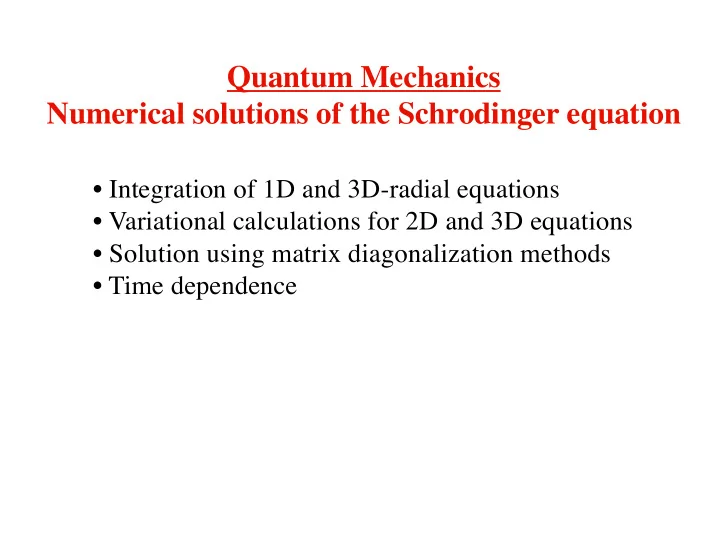

Quantum Mechanics Numerical solutions of the Schrodinger equation • Integration of 1D and 3D-radial equations • Variational calculations for 2D and 3D equations • Solution using matrix diagonalization methods • Time dependence
Brief review of quantum mechanics In classical mechanics, a point-particle is described by its position x(t) and veloity v(t) • Newton ’ s equations of motion evolve x,v as functions of time In quantum mechanics, x and v cannot be precisely known simultaneously (the uncertainty principle). A particle is described by a wave function Y (x,t) • the probability of the particle being in a volume dx is Y (x,t) • The Schrödinger equation evolves in time • There are energy eigenstates of the Schrodinger equation - for these, only a phase changes with time Þ Finding the energy eigenstates (stationary states) is an important task
Stationary Scrodinger equation in three dimensions Spherical symmetric potentials; separable Radial wave function Similar to purely one-dimensional problems
Numerov ’ s method (one dimension) Stationary Schrodinger equation Can be written as (also radial function in three dimensions) Discretization of space: . Consider Taylor expansion ∞ ∆ n � n ! Ψ ( n ) (0) Ψ ( ∆ x ) = Ψ (0) + x n =1 Add expansions for Second derivative determined by the Schrodinger equation How to deal with the fourth derivative?
Central difference operator 1 δ 2 g ( x ) + O ( ∆ 2 g 00 ( x ) = x ) ∆ 2 x We can rewrite the previous equation using the second central difference, giving Approximate the fourth derivative leads to the general result
Schrodinger equation gives More compact notation: Introduce function Fortran implementation do n=2,nx q2=dx2*f1*psi(n-1)+2.d0*q1-q0 q0=q1; q1=q2 f1=2.d0*(potential(dx*dble(n))-energy) psi(n)=q1/(1.d0-dx2*f1) enddo
Boundary-value problems The Schrodinger equation has to satisfy boundary conditions Ø quantization , as not all energies lead to valid solutions Example: Particle in a box (infinite potential barrier) Using Boundary conditions: How do we proceed in a numerical integration?
Choose valid boundary conditionas at x=-1 A is arbitrary (not 0); normalize after solution found “ Shooting method ” Pick an energy E Ø Integrate to x=1 Ø Is boundary condition at x=1 satisfied? Ø If not, adjust E, integrate again Ø Use bisection to refine
Solving an equation using bisection (general) We wish to find the zero of some function First find E 1 and E 2 bracketing the solution Then evaluate the function at the mid-point value Choose new bracketing values: Repeat procedure with the new bracketing values - until
Bisection search for the ground state Ø First find E1, E2 giving different signs at x=+1 Ø Then do bisection within these brackets
More complicated example: Box with central Gaussian potential barrier Ground state Search
First excited state
Potential well with non-rigid walls Looking for bound state; Asymptotic solution: A=0 for x>0 B=0 for x<0 Use the asymptotic form for two points far away from the center of the well Find E for which the solution decays to 0 at the other boundary
Ground state search Using criterion:
Recommend
More recommend